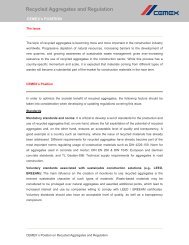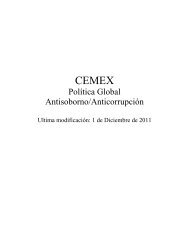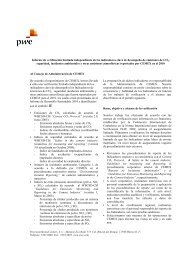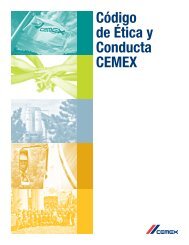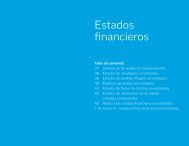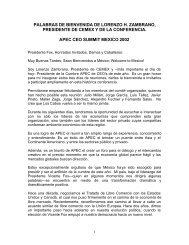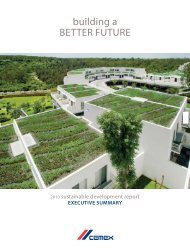building a STRONGER foundation - Cemex
building a STRONGER foundation - Cemex
building a STRONGER foundation - Cemex
Create successful ePaper yourself
Turn your PDF publications into a flip-book with our unique Google optimized e-Paper software.
foreign subsidiaries. These instruments have been negotiated with institutions with significant financial capacity; therefore, we<br />
consider the risk of non-compliance with the obligations agreed to by such counterparties to be minimal.<br />
Derivative financial instruments are recognized as assets or liabilities in the balance sheet at their estimated fair values, and the<br />
changes in such fair values are recognized in the statements of operations for the period in which they occur, except for changes in the<br />
fair value of derivative instruments that are designated and effective as cash flow hedges and hedges of the net investment in foreign<br />
subsidiaries. Some of our instruments have been designated as cash flow hedges. For the years ended December 31, 2010, 2009 and<br />
2008, we have not designated any fair value hedges. See note 12C to our consolidated financial statements included elsewhere in this<br />
annual report.<br />
Interest accruals generated by interest rate swaps and/or cross-currency swaps are recognized as financial expense, adjusting the<br />
effective interest rate of the related debt.<br />
Pursuant to their recognition at fair value under MFRS, our balance sheets and statements of operations are subject to volatility<br />
arising from variations in interest rates, exchange rates, share prices and other conditions established in our derivative instruments.<br />
The estimated fair value under MFRS represents the amount at which a financial asset could be bought or sold, or a financial liability<br />
could be extinguished at the reporting date, between willing parties in an arm’s length transaction. Occasionally, there is a reference<br />
market that provides the estimated fair value; in the absence of a market, such value is determined by the net present value of<br />
projected cash flows or through mathematical valuation models. The estimated fair values of derivative instruments determined by us<br />
and used by us for recognition and disclosure purposes in the financial statements and their notes are supported by the confirmations<br />
of these values received from the counterparties to these financial instruments, which act as valuation agents in these transactions;<br />
nonetheless, significant judgment is required to appropriately account for the effects of derivative financial instruments in the financial<br />
statements. Beginning in 2008, the definition of fair value under U.S. GAAP was redefined by ASC 820, Fair Value Measurements<br />
and Disclosure (formerly SFAS 157, Fair Value Measurements), as an “Exit Value,” which created a difference between MFRS and<br />
U.S. GAAP. An “Exit Value” is the price that would be received to sell an asset or paid to transfer a liability in an orderly transaction<br />
between market participants at the measurement date. The difference between the fair value under MFRS, which is equivalent to a<br />
settlement amount at the balance sheet date, and the Exit Value under U.S. GAAP, is that the latter considers the counterparty’s credit<br />
risk in the valuation. See notes 12C and 24(h) to our consolidated financial statements included elsewhere in this annual report.<br />
The estimated fair values of derivative financial instruments fluctuate over time, and are based on estimated settlement costs or<br />
quoted market prices. These values should be viewed in relation to the fair values of the underlying instruments or transactions, and as<br />
part of our overall exposure to fluctuations in foreign exchange rates, interest rates and prices of shares. The notional amounts of<br />
derivative instruments do not necessarily represent amounts exchanged by the parties and, therefore, are not a direct measure of our<br />
exposure through our use of derivatives. The amounts exchanged are determined on the basis of the notional amounts and other<br />
variables included in the derivative instruments.<br />
Impairment of long-lived assets<br />
Our balance sheet reflects significant amounts of long-lived assets (mainly fixed assets and goodwill) associated with our<br />
operations throughout the world. Many of these amounts have resulted from past acquisitions, which have required us to reflect these<br />
assets at their fair market values at the dates of acquisition. According to their characteristics and the specific accounting rules related<br />
to them, we assess the recoverability of our long-lived assets at least once a year, normally during the fourth quarter, as is the case for<br />
goodwill and other intangible assets of indefinite life, or whenever events or circumstances arise that we believe trigger a requirement<br />
to review such carrying values, as is the case with property, machinery and equipment and intangible assets of definite life.<br />
Goodwill is evaluated for impairment by determining the value in use of the reporting units, which consists of the discounted<br />
amount of estimated future cash flows to be generated by such reporting units to which goodwill relates. A reporting unit refers to a<br />
group of one or more cash generating units. Each reporting unit, for purposes of the impairment evaluation, consists of all operations<br />
in each country. An impairment loss under MFRS is recognized if such discounted cash flows are lower than the net book value of the<br />
reporting unit. In applying the value in use method, we determine the discounted amount of estimated future cash flows over a period<br />
of five years, unless a longer period is justified in a specific country considering its economic cycle and the situation of the industry.<br />
For the years ended December 31, 2008, 2009 and 2010, the geographic segments we reported in note 3A to our consolidated<br />
financial statements included elsewhere in this annual report, each integrated by multiple cash generating units, also represent our<br />
reporting units for purposes of testing goodwill for impairment. Based on our analysis, we concluded that the operating components<br />
that integrate the reported segments have similar economic characteristics, by considering: (a) the reported segments are the level used<br />
by us to organize and evaluate our activities in the internal information system, (b) the homogenous nature of the items produced and<br />
traded in each operative component, which are all used by the construction industry, (c) the vertical integration in the value chain of<br />
the products comprising each component, (d) the type of clients, which are substantially similar in all components, (e) the operative<br />
integration among operating components, evidenced by the adoption of shared service centers, and (f) the compensation system of any<br />
of our country operations is based on the consolidated results of the geographic segment and not on the particular results of the<br />
components.<br />
81



